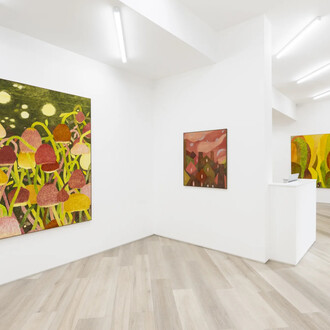Saudi-born, Pakistani-American artist Nadia Waheed has lived in places such as Islamabad, Paris, Sydney, Cairo, and the USA. In fact, she hasn’t lived in the same place for longer than four years. As such, the notion of displacement, vulnerability and identity has undoubtedly woven itself into her paintings. She states that the figures in her paintings are herself - but also others: "The women are [versions of] me, but also others. They’re two women, but also one woman...women contain multitudes", she states.
In a similar vein, the works of Malaysian sculptor Haffendi Anuar speak to a similar notion of identity in flux - although his concern is less about the 'self' and more about the external environment. Like Waheed, Anuar has lived in London, Rhode Island, and China, and this desire to comprehend one's place in the world has - for Anuar - manifested in the form of the piloti. Pilotis are structural columns made to lift a building from the ground, and/or above water. As such, they function duplicitously: by both providing the connection to a foundation but also by offering a detachment from said foundation. In the same instance, both artists are talking about singularity - and multiplicity.
Waheed's work explores ideas of selfhood, conflict, and desire for detachment. In many works, she appears almost levitating, withouth foundation (quite literally the antithesis to Anuar's masculine totems), where female bodies are suspsended in mid-air, braids, limbs, and legs intertwined. Pakistani women are painted in bold colours (hiding their true skin colour), with cultural signifiers such as bridal mehndi, razai blankets, and long braided hair being the elements that form the individuals’ identities. This particular body of work paints an image of quiet and enduring resilience; uncelebrated and invalidated effort to confront and establish identity. This feeds into an overarching exploration: a questioning of what ‘womanhood’ means given the current cultural climate. With grandiose conflicts like Brexit and Trump, (the latter particularly relevant for a young American woman), and the art-world going through a re-evaluation of women's and ethnic perspectives, these works (despite their often saccharine hues) offer stark and poignant perspectives of our current political climate.
For Anuar, his Asian heritage has fed into an interest in the use of these architectural elements in Southeast Asian architecture; in this part of the world, they are used to elevate buildings from floods and dangerous ground-dwelling animals such as snakes and scorpions. Like Waheed, the work finds meaning through conflict. But unlike Waheed, Anuar's concern is thrust outward, where geographies, cities, and infrastructure become metonym for custom, process, and culture. Through a repetitive (somewhat ritualistic) method, the artist paints each individual piloti with up to one hundred layers of paint; over the course of weeks, he will apply layers with an almost religious-like devotion: one layer in the morning, one layer in the afternoon. This temporal element further arises through Anuar’s hand-sanding of the surface, exposing the inner layers; the effect is almost like a faux-antique, where the passage of time’s corrosion and patination of the surface has been replicated. The sculptures’ original form as steadfast columns (used to hold heavy buildings) have been diminished–now, placed on the floor, they look like small, vulnerable lifeforms. Combined with the work of Waheed, we are called to question how such personal moments can become transformed into metaphoric or grandiose gestures, and- conversely - how the monumental can be reimagined as something intimate, personal, and ritualistic.
















